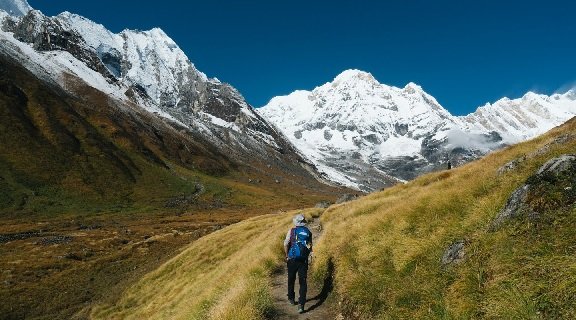This fully guided and all-inclusive two or five-grand price point can add up to several thousand dollars, but you’d be surprised at just how affordable this epic Himalayan adventure is even for a budget-conscious traveler. But with a little smarts in planning, a willingness to try things on your own, and a taste of local life, the classic trek can be done without ransacking your wallet. This guide will share with you all the strategy and sciencey stuff to turn your dream of trekking the Annapurna Circuit into a shoestring reality!
Easy-Peasy Permit Mastery: Saving You Time And Money On The Pre-trek Fine Print
The Annapurna region is a restricted conservation area, so you need to get two mandatory permits before heading out for the trek. Those are the Annapurna Conservation Area Permit (ACAP) & the Trekkers’ Information Management System (TIMS) Card. The best and cheapest thing to do would be to head straight into the offices of the Nepal Tourism Board, either in Kathmandu or Pokhara. If you choose an agency to do this for you, they tack on a service fee on top of these costs. After you’ve put in the legwork yourself by sitting through the paperwork, a simple non-negotiable fee remains just that — simplistic. Carry passport photos and plenty of local currency to keep things ticking over, as this will be the most important first purchase for a self-sufficient, cheap-as-chips trek.
Independent Trekking Versus Guided Packages
Other things will influence the budget, but BY FAR the single largest decision is what you do about a guide or porter. Though that might sound tempting, the expense of a fully-loaded trek includes agency fees, guide’s wages, and porter costs, which also increase the total, and add up pretty high. The Annapurna Circuit Trek is very popular, well-trodden, and easy to follow, so one can easily hike it without a guide. There are teahouses every hour or so along the trail, and not terribly many places to go wrong if you’ve got a map and a good navigation app. On the one hand, it supplies the protectorate with FYI + funding to the local economy. Venturing alone (or even with merely your travelling partner) shaves more than 300$ off of daily costs! If you are a little unsure about finding the balance between safety and support, then why not hire an affordable porter-guide to pay for your rudimentary guiding service, sharing the weight, at less cost than what you would pay everyone individually?
Transportation: Opting for Local Travel
Travel to and from the Annapurna Circuit Trekking trailhead/Kathmandu is a considerable cost, but one that can be negotiated. The cheapest way, other than avoiding tourist buses and private jeeps, is to take a public non-facilitated bus or microbus. The rides are slow, slightly less comfortable, and often packed with other people, but the savings can be substantial: a fraction of the cost of going private. For example, it is much less expensive when done by public transport to somewhere one can easily find a regular starting place ( e.g, Besisahar from Pokhara or Kathmandu) and walk to Syange or Dharapani. Then, once on the trail, don’t be tempted to jump onto shared jeeps—particularly those doing road stretches. And going all the way also saves ya dough and better prepares yerself for different landscapes, all on your shoestring!
Accommodation: The Teahouse Economy
And it’s where accommodating comes in as the real star of shoestring travel. The teahouses function on a rudimentary and critical form of economics: You are expected to eat breakfast and dinner primarily at the place you sleep. (Character attributed it partly to an unspoken pact among tea-house owners; since as soon as you settle down in one house, a porter is sent off to start a fire at the next, tents are bound to be pitched out of doors at night and kitchens in all common use: Chairs and a table offer themselves on reception; alternating hot water is provided if demanded.) The result of this unwritten bargain means that the price for floor space — most often twin sharing, meager bedding included — is similarly low: Might be zero below certain elevations. If you want to protect your wallet, always ask about the cost, you are prepared for Dal Bhat (just at night), and learn to politely say no. Hot showers, Wi-F, and charging of your batteries are extra services that you are charged for; go easy. Some of the simplest and most effective ways to avoid these costs are also downright primitive – consider a solar-heated shower, books instead of Wi-Fi, and a fully charged power bank.
Packing Smart and Renting Gear
Your pack is one of the most important components to both your creature comfort and how much weight you rely on your wallet to purchase when trekking, so you will want to begin with the lightest one that works for you. You don’t need to become the type of person who goes out and buys all new high-spec gear. Instead, stick to your trusted essentials and rent higher-priced gear in Kathmandu or Pokhara. Good down jackets, good sleeping bags (which are quite important as you have to sleep at high altitude), and walking poles can also be rented more easily for a fraction of the cost of purchasing. Don’t spend much on-the-trail garbage like this. Items*“sum you pay is ridiculous, and carry water/beverages in not disposable bags to be super prepared. Take (a lot of) layers (7-8 on the t, o,p, etc) broken-in in boots, and a few basics from home as well (first aid kit stuff). Cuz everything you have to buy is bloody expensive for anything small/medicine. By renting that heavy, expensive gear, you cut down your initial outlay and sidestep the price of an additional checked bag on each flight.
Side Expenses: Reeling In the Extras
The costs of living “on the side,” so to speak, on a trek are the silent budget assassins. These range from fees for a hot shower, WiF, and charging your electronics — especially as you climb higher to Thorong Phedi and High Camp. Be disciplined. Pack a small solar charger to charge your phone and camera (or a really big power bank), so you’re not charged to use the plug. For quick washes, cold water, or wait for that hot shower in lower-altitude towns like Manang or Muktinath for a lot less—or no—cost at all. And remember, even staples like toilet paper are pricey on the trail, so make sure to stock up in a city before you start. It adds up, these choices not to have a comfort here or there, and the next thing I know, we’ve saved hundreds of dollars over two weeks.
Acclimate and Pace: Slow is Cheaper
Proper acclimatisation is not just a safety concern, but it has a huge impact on the bottom line. A dash-hop, to save on nightly lodging, is a fool’s errand. AMS can be deadly, and you may end up paying for a helicopter rescue or an emergency descent, killing your wallet. The two rest days recommended (that we did in Manang) for “climb high, sleep low” trekkers are well worth it for walks to Ice Lake/Way and Milarepa’s Cave. Slow and steady pace, listening to your body, and conservative ascent profiles are ways you can minimize the chances of getting ill, and there is no shortcut for that; also, considering the budget plan for 12-16 days as advised for doing the circuit responsibly!
Conclusion- What You Will Take Away from the Annapurna Circuit.
Trekking the Annapurna Circuit on a budget – it’s a humbling lesson in the self-sufficient, mindful type of travel. The final figure is very conservative, I reckon, and I’m guessing that you will be well under the mark of the average tour spend – tho’ it all depends if you have ‘take out cut’ experience in mind or not. It is your creativity, thoroughness, and the ability to immerse yourself in the way of life in just one place that will mark the achievement. I firmly believe that by organising your own permits rather than ticking off a whole package tour, using local transport along with eating and living through the Dal Bhat principle of ‘eat as much as you like’, cutting down on luxuries, then it is what respects the country and gets to enjoy its amazing landscapes. The mountains are magic for all, regardless of what’s in your bank balance, and with these tips yo u can be ready to take on one of the world’s great treks without casting a chill down your spine from the size of the seed capital.
Refresh Date: October 29, 2025







